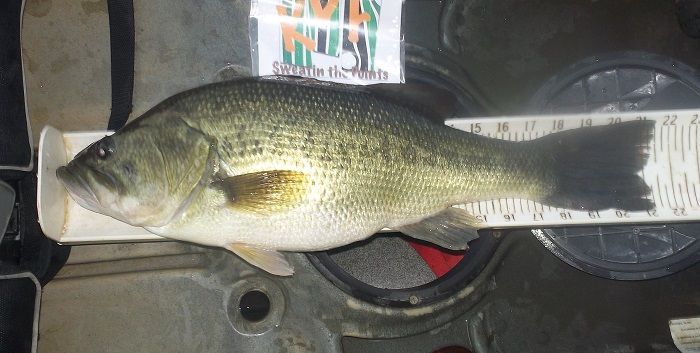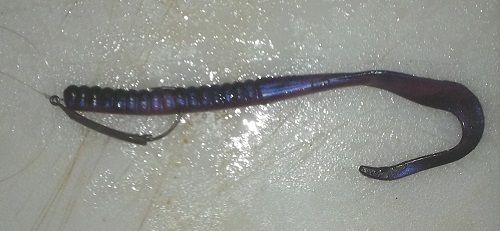Got out on the water for a couple of hours after work on Tuesday. Here is a picture which I think should fully explain how it went. 

She ate my favorite presentation during the warm water period (when the water gets up around 80 degrees or warmer) which is a big 10" ribbontail plastic worm. The bigger worm discourages the smaller bass and frequently seems to be just the ticket for the size largemouth bass I am most interested in (those that are 20" and larger). I anchored up on a major point in 20 feet of water and slowly crawled the worm along the bottom. This bass was almost directly underneath the kayak when she hit. On a heavily pressured lake like Little Seneca it pays to be deadly silent in your kayak.

I fish these big worms on 1/4 ounce and 3/8 ounce Confidence Baits Draggin' Heads as I find that jig head has a number of advantages.
1. the Draggin' Head is extremely snag proof, you can drag them through rocks and weeds without getting hung up or collecting vegetation
2. no line twist, a big ribbontail worm fished on a traditional Texas Rig is gonna spin, years ago before I started using Draggin' Heads I would have to troll my line behind the kayak without a lure attached to untwist my line after a few hours of throwing the big worm
3. the hook stays pointed up, Draggin' Heads don't tip over which helps avoid snags and also generally puts the hook point into the roof of the mouth of the bass (much better place to stick a bass), I have tried other swimbait weighted hooks but they have a tendency to tip to their side and expose the hook point to potential snags
4. you have a much more direct contact with your presentation, there is a concept referred to as "weighing your jig" during the retrieve, any change in the weight that you feel through your rod could mean a bass has picked up your worm (with a plastic worm on a Texas Rig with a sliding bullet sinker you can feel the weight of the "sinker" but your worm might already have been taken by a bass without your feeling it)
5. with the Draggin' Head acting like a keel to keep the body of the worm upright you get the full effect of the "thump" from the ribbontail
6. this presentation has something of a horizontal swim to it on the descent after the cast, watch your line carefully as you may get popped during the initial drop of the worm


She ate my favorite presentation during the warm water period (when the water gets up around 80 degrees or warmer) which is a big 10" ribbontail plastic worm. The bigger worm discourages the smaller bass and frequently seems to be just the ticket for the size largemouth bass I am most interested in (those that are 20" and larger). I anchored up on a major point in 20 feet of water and slowly crawled the worm along the bottom. This bass was almost directly underneath the kayak when she hit. On a heavily pressured lake like Little Seneca it pays to be deadly silent in your kayak.

I fish these big worms on 1/4 ounce and 3/8 ounce Confidence Baits Draggin' Heads as I find that jig head has a number of advantages.
1. the Draggin' Head is extremely snag proof, you can drag them through rocks and weeds without getting hung up or collecting vegetation
2. no line twist, a big ribbontail worm fished on a traditional Texas Rig is gonna spin, years ago before I started using Draggin' Heads I would have to troll my line behind the kayak without a lure attached to untwist my line after a few hours of throwing the big worm
3. the hook stays pointed up, Draggin' Heads don't tip over which helps avoid snags and also generally puts the hook point into the roof of the mouth of the bass (much better place to stick a bass), I have tried other swimbait weighted hooks but they have a tendency to tip to their side and expose the hook point to potential snags
4. you have a much more direct contact with your presentation, there is a concept referred to as "weighing your jig" during the retrieve, any change in the weight that you feel through your rod could mean a bass has picked up your worm (with a plastic worm on a Texas Rig with a sliding bullet sinker you can feel the weight of the "sinker" but your worm might already have been taken by a bass without your feeling it)
5. with the Draggin' Head acting like a keel to keep the body of the worm upright you get the full effect of the "thump" from the ribbontail
6. this presentation has something of a horizontal swim to it on the descent after the cast, watch your line carefully as you may get popped during the initial drop of the worm


Comment